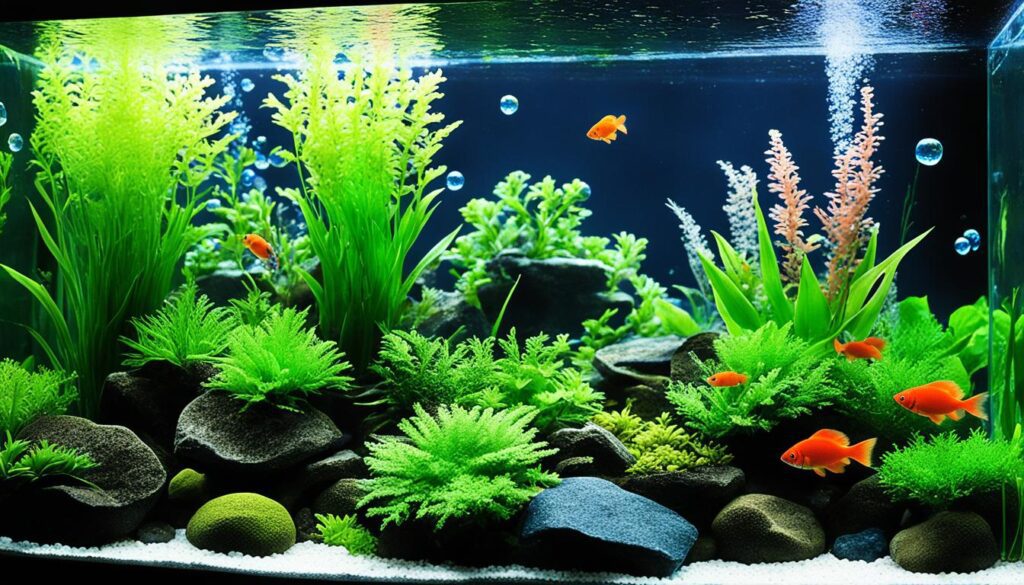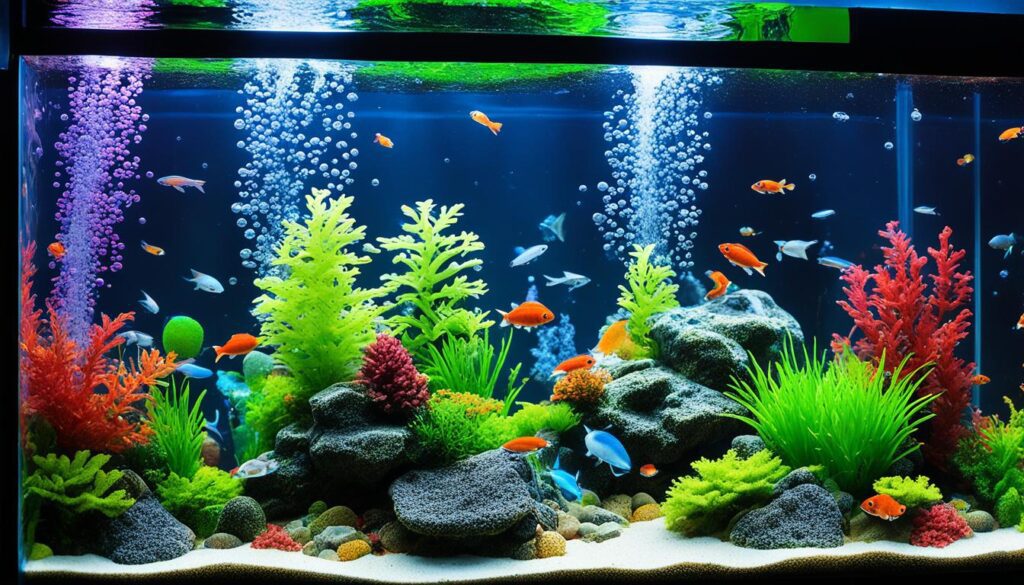Welcome, fellow aquarists! As we dive into the world of fish tanks, let’s talk about the importance of oxygen. Have you noticed your fish aren’t as lively as they could be? This might be due to a lack of oxygen. Let’s learn about the best ways to add oxygen to our aquariums, making sure our fishy friends thrive.
Did you know fish get about 80 percent of their oxygen from water? This is much more efficient than us breathing air. But, keeping the right oxygen levels in their water is crucial. Since water has much less oxygen than air, and is denser, our fish need our help to breathe easily.
Looking at my 20-gallon long tank, I see how important the surface area is for oxygen. A tank’s shape matters a lot for providing enough oxygen to our fish. Also, did you know warm water holds less oxygen? Or that fish meds can affect oxygen levels too?
Some fish, like goldfish and gouramis, can handle low oxygen. But, we should keep oxygen levels just right, aiming for an 80-110% saturation. Think of it like this: just as a great library draws in readers, a well-oxygenated tank attracts lively fish.
What if our tanks start showing signs of low oxygen, like fish gasping for air? It’s our job to fix it. We need to pick the right equipment and methods to bring the oxygen back. Let’s make sure our tanks are full of life, not silence.
Our journey in keeping our fish happy involves balancing water and watching oxygen levels closely. Let’s uncover the secrets of aeration together. After all, every tank is its own little world, and every fish in it needs our care to live well.
The Importance of Oxygen in Aquatic Habitats

Oxygen is vital in water habitats, especially for aquarium fans. It’s not only about keeping the water fresh. It directly impacts the health and activity of fish. The right amount and stability of oxygen are key to life under water.
Understanding Dissolved Oxygen Levels
Oxygen gets into water from the air, photosynthesis, or water movement like filtration. Dissolved oxygen is crucial for fish and other water creatures. To keep aquatic pets healthy, it’s important to measure oxygen and maintain the best levels.
Impact of Oxygen on Fish Metabolism and Health
Studies show that enough oxygen helps fish metabolize better. This improves growth and immune function. With more oxygen, fish have better metabolism and stronger immune systems. This makes them less likely to get sick.
Low oxygen can cause stress and health issues for fish, shortening their lives. Signs like fish gasping for air or rapid gill movements signal the need for quick help.
Oxygen Variability in the Water due to Environmental Factors
Temperature, pressure, how many fish, and the weather can all affect oxygen levels. Warm water and too many fish lower oxygen levels. Handling these factors means controlling tank temperature, not having too many fish, and using air pumps for better oxygen flow.
Factor |
Influence on Oxygen Levels |
Management Strategies |
|---|---|---|
Temperature |
Higher temperatures decrease oxygen solubility |
Maintain cooler, stable water temperatures |
Stocking Density |
More fish consume more oxygen |
Avoid overstocking |
Water Movement |
Poor circulation can create zones of low oxygen |
Utilize water pumps and air stones |
External Weather |
Barometric pressure impacts gas exchange |
Monitor weather changes and adjust tank management accordingly |
Watching and managing environmental factors and technology can improve aquatic habitats. Making sure water has enough oxygen is essential for marine life to thrive. It shows how well an aquarium’s ecosystem is managed.
Signs Indicating Your Fish Tank Needs More Oxygen

Knowing when your fish tank is low on oxygen is crucial. It helps keep your fish alive and healthy. Look for signs of stress and take action quickly.
Here are the key signs and symptoms to watch for in your tank.
Observing Fish Behavior for Clues
If your fish are gasping at the water’s surface, something might be wrong. This is one of the first signs of low oxygen. They might also move less than normal.
Fish trying hard to breathe or acting tired are also warning signs. They might not eat much, which is easy to miss until it’s serious.
Physiological Stress Symptoms in Fish
Physical signs also hint at low oxygen. These include lighter gills, fins held close, and dull colors. Checking your fish often is key.
This way, you can act fast if their health gets worse.
Condition |
Impact |
Preventive Measure |
|---|---|---|
Overstocking |
Decreases available oxygen |
Limit fish population |
Inadequate Filtration |
Poor water circulation & low oxygen |
Install high-capacity filters |
High Temperature |
Reduces dissolved oxygen levels |
Monitor and adjust temperature |
Organic Decay |
Consumes oxygen rapidly |
Regular cleaning to remove waste |
Surface Agitation |
Low oxygen exchange |
Use air stones or surface agitators |
When things look bad, checking oxygen levels with a test kit helps. Using the right aeration keeps your tank healthy. Do regular maintenance.
Simple and Effective Aeration Techniques

It’s very important to know about aeration for a healthy water environment. A tank with good aeration helps fish stay healthy and improves water quality. Let’s look at easy ways to add air to fish tanks, so your underwater friends do well.
Putting air pumps and air stones in the right spots is a key step to get more oxygen in the tank. Aquarium Coop has studies showing air stones work better than just stirring the water’s surface. They make tiny bubbles which help mix air and water better, adding more oxygen. This is crucial since air has only 21% oxygen, and water naturally has even less.
Filters also help add air to the water, in a supporting role. Using a powerhead or canister filter with a special outlet can mix the water at the top without strong currents. This makes the water take in more oxygen, which fish need to stay healthy.
A study from Ball State University found that aquariums with an airstone under the gravel had the most oxygen, at 7.5 ppm. This shows how vital the right equipment is for moving oxygen into the water effectively.
In places where power cuts happen, having a backup like a battery-operated air pump is smart. This keeps the air flowing when there’s no electricity, preventing fish deaths from low oxygen.
When choosing how to add air to your tank, think about what the fish need and prefer. Keep checking and adjusting to make sure there’s enough air at the water’s surface. This keeps oxygen levels high and your aquarium’s ecosystem thriving.
The aim is to pick an aeration method that fits your aquarium’s specific needs. Good aeration doesn’t just keep fish alive. It makes your tank’s world richer, showing off your fish at their best.
While quick fixes can help with aeration, steady, sure methods like the right filter and air stones set the stage for a healthy aquarium. These approaches keep your water’s oxygen and quality top-notch for the long run.
Oxygenating a Fish Tank Through Water Movement
I love keeping my fish healthy and vibrant. It’s important to keep the water moving in their tank. This not only looks nice but is essential for the fish. By increasing the oxygen with air pumps and airstones, my cichlids and bettas stay healthy. This also means less disease and clearer water without as much algae.
Integration of Air Pumps and Airstones
Using air pumps and airstones has been a game-changer for me. They do more than just add oxygen. An airstone spreads oxygen evenly, helping my fish breathe better. It also keeps the temperature stable, which is super important in the summer.
Utilizing Filter-Induced Surface Agitation
Don’t overlook what a filter can do. My canister filter, with its spray bar, cleans the water and adds oxygen. By stirring the water’s surface, it lets oxygen in and carbon dioxide out. This keeps my fish safe, especially when I change the water.
These aeration methods really make a difference. They keep my tank healthy and give me peace of mind. Seeing my fish swim in clear water makes everything worth it. It shows me that I’m doing a great job caring for my underwater world.








